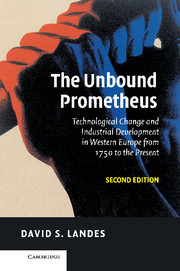 The Unbound Prometheus
The Unbound Prometheus Published online by Cambridge University Press: 05 June 2014
The period from 1850 to 1873 was Continental industry's coming-of-age. It was a period of unprecedentedly rapid growth, which may be best conveyed—in the absence of year-by-year calculations of national income or product—by certain critical time series: railroad mileage, coal consumption or output, steam-power capacity, make of pig iron, consumption of raw cotton. In all these areas (with the exception of cotton, whose manufacture suffered a grievous setback in the 1860's), whether for France, Belgium, or Germany, the compound rate of increase runs between 5 and 10 per cent a year (see Table 4).
These were also years of technological maturation. They were marked in essence by the working-out on the Continent of those innovations that constitute the heart of the Industrial Revolution and had been developed and diffused in Britain a generation or more earlier. In textiles the self-actor and power loom replaced the mule and hand loom. The iron industry consummated the shift from vegetable to mineral fuel. The steam-engine sealed its triumph over the water wheel. The heavy chemical industry was firmly established and the technical possibilities of the salt-soda-acid complex exploited along the lines implicit in the Leblanc process. Finally, the machine spread ever more widely—into nail-making and the cutlery trade, the stamping of heavy metal forms, tailoring, the manufacture of paper, and other fields too numerous to list.
This description of the middle decades of the century as a period of technical maturation, of the working-out and diffusion of earlier developments, is not meant to imply that invention had ceased and that the gains of productivity were all made behind a stable technological frontier.
To save this book to your Kindle, first ensure no-reply@cambridge.org is added to your Approved Personal Document E-mail List under your Personal Document Settings on the Manage Your Content and Devices page of your Amazon account. Then enter the ‘name’ part of your Kindle email address below. Find out more about saving to your Kindle.
Note you can select to save to either the @free.kindle.com or @kindle.com variations. ‘@free.kindle.com’ emails are free but can only be saved to your device when it is connected to wi-fi. ‘@kindle.com’ emails can be delivered even when you are not connected to wi-fi, but note that service fees apply.
Find out more about the Kindle Personal Document Service.
To save content items to your account, please confirm that you agree to abide by our usage policies. If this is the first time you use this feature, you will be asked to authorise Cambridge Core to connect with your account. Find out more about saving content to Dropbox.
To save content items to your account, please confirm that you agree to abide by our usage policies. If this is the first time you use this feature, you will be asked to authorise Cambridge Core to connect with your account. Find out more about saving content to Google Drive.